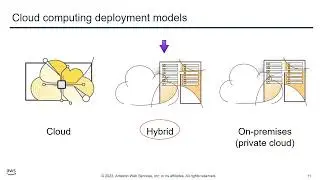Cloud Computing Deployment Models || Module 1 Cloud Concepts Overview || AWS Academy Cloud Foundati
There are three main cloud computing deployment models, which represent the cloud environments that your applications can be deployed in:
Cloud: A cloud-based application is fully deployed in the cloud, and all parts of the application run in the cloud. Applications in the cloud have either been created in the cloud or have been migrated from an existing infrastructure to take advantage of the benefits of cloud computing (see https://aws.amazon.com/what-is-cloud-.... Cloud-based applications can be built on low-level infrastructure pieces or they can use higher-level services that provide abstraction from the management, architecting, and scaling requirements of core infrastructure.
Hybrid: A hybrid deployment is a way to connect infrastructure and applications between cloud-based resources and existing resources that are not located in the cloud. The most common method of hybrid deployment is between the cloud and existing on-premises infrastructure. This model enables an organization to extend and grow their infrastructure into the cloud while connecting cloud resources to internal systems.
On-premises: Deploying resources on-premises, using virtualization and resource management tools, is sometimes called private cloud. While on-premises deployment does not provide many of the benefits of cloud computing, it is sometimes sought for its ability to provide dedicated resources. In most cases, this deployment model is the same as legacy IT infrastructure, but it might also use application management and virtualization technologies to increase resource utilization.
#cloud #awsacademy #deploymentmodels #cloudcomputing #aws




![Real Big Boss [Alchemist] Hard Carry Machine Farming Max Slow Build Enemy Can't Run Dota2 7.34b](https://images.videosashka.com/watch/zmSK_4zB_d8)














